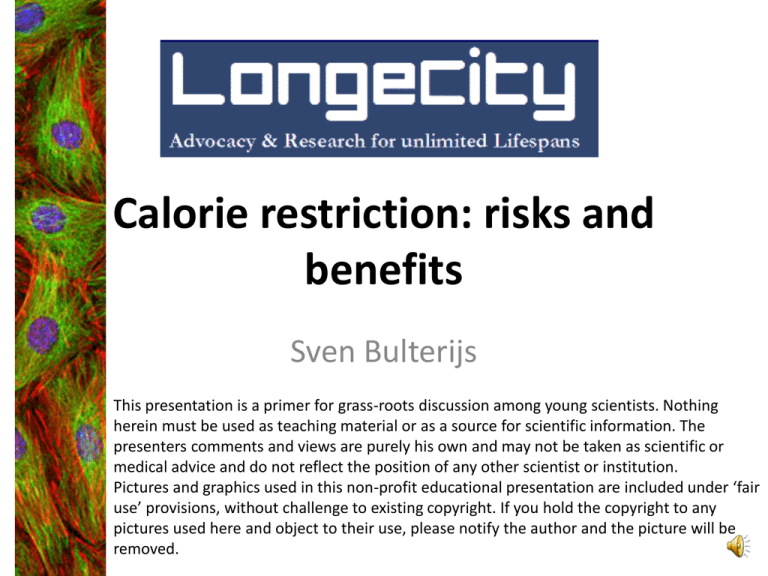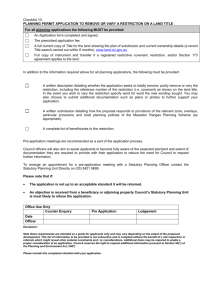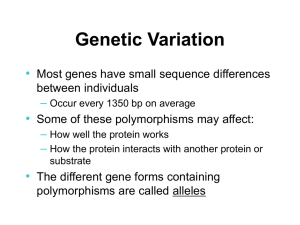
Calorie restriction: risks and
benefits
Sven Bulterijs
This presentation is a primer for grass-roots discussion among young scientists. Nothing
herein must be used as teaching material or as a source for scientific information. The
presenters comments and views are purely his own and may not be taken as scientific or
medical advice and do not reflect the position of any other scientist or institution.
Pictures and graphics used in this non-profit educational presentation are included under ‘fair
use’ provisions, without challenge to existing copyright. If you hold the copyright to any
pictures used here and object to their use, please notify the author and the picture will be
removed.
Benefits
Life span extension: obviously
• E. coli, yeast, water striders, rotifers, C.
elegans, mosquitos, Drosophila, spiders,
mice, rats, hamsters, guinea pigs, fish, and
dogs
• Increase in survival in monkeys
• But not in: Musca domestica (house fly),
Ceratitis capitata (Mediterranean fruit fly),
Speyeria mormonia (Mormon Fritillary),
and in some water striders (Gerris sp.) and
rotifers
Life span extension: obviously
From: Weindruch and Walford, Charles C Thomas, Springfield, 1988
Insulin resistance
• Type 2 diabetes: 20% of Americans aged 60 to
75
• CR restored hepatic insulin sensitivity in 18
month old rats to levels of 4 month old
• Reason: CR decreases visceral fat (VF)
• Surgical removal of VF improved hepatic
insulin action by more than 2-fold
• Quick improvement in insulin sensitivity after
gastric bypass (often within 10 days)
• In obese people 8 weeks of severe CR (600
kcal/day) reversed type 2 diabetes
Cardiovascular disease
• Mortality from CAD decreased during WWII
• Decrease in diastolic and systolic blood
pressure, LDL, triglycerides, total cholesterol,
glucose, glycated hemoglobin, and C-reactive
protein
• HDL: decreased in a small sample size study
but increase in a bigger one
• CR also protects against cardiomyopathy
• In a rat model of myocardial infarction the
size of the infarct was 2-fold smaller in
intermittent fasting (IF) animals
Cancer
• In 1909: inhibition of growth of transplanted
tumors
• Also inhibition of spontaneous tumor incidence,
chemically and radiation-induced tumors
• For example in (Begga et al., 1995) 40% CR
resulted in a decrease in breast tumor incidence
(63-68% vs 21%), tumor burden (1.84-2.05 vs 0.370.43 tumors/rat), and tumor weight (7.1-11.9 vs
1.4-2.2g)
• Short term fasting protects healthy cells but not
cancer cells against toxicity of chemotherapy
(when LID mice where given doxorubicin none of
the AL animals survived but 60% of the fasting
survived)
Memory function
• Delays age-related declines in psychomotor and
spatial memory tasks in mice
• CR appeared to attenuate age-related alterations in
some parts of the white matter in the brain.
• Improves memory function
in elderly humans
• Less iron accumulation
might partially explain
these benefits.
PNAS, 2009, 106: 1255-1260
Alzheimer’s disease
• 5.3 million cases in the US
• Decrease in Aβ1-40 and Aβ1-42 in the
temporal cortex of Squirrel monkeys
• Prevents neuritic plaque formation in
Tg2576 mice
Sarcopenia
Lifelong mild (8%) caloric restriction retards ageinduced changes in fast-twitch muscle (plantaris)
morphology including fiber atrophy, increased
extramyocyte space, and accumulation of connective
tissue
Exp Gerontol, 2008,
43: 317-329
Autoimmune disease
• Reduced autoimmune disease in normal
and autoimmune prone (NZB, (NZB x
NZW)F1, MRL/Mp-lpr/lpr, BXSB, and kd/kd)
mice
• Mechanism: CR reduces proliferation rate
of lymphoid cells of the thymus, spleen,
and mesenteric lymph nodes
Risks
Hunger
• Restricted animals show signs of hunger
• Hunger depends on diet composition low
calorie-dense diet
• A cross-sectional survey of 7356 adults in the
US shows that those with a low energydensity diet had lower energy intakes even
though they consumed more food by weight
• However, the feeling of hunger itself might
have health benefits. Hunger is caused by
ghrelin but ghrelin also promotes memory
and neurogenesis, inhibits NFκB, and
improves immune function
Osteoporosis
• CR causes bone loss and a decrease in
bone mineral density in rodents and
humans
• 35% CR in humans for between 3 and 20
years does not decrease bone quality
Susceptibility to infections
• CR in general has a beneficial effect on
molecular and cellular immune-function
• Only 3 studies with intact pathogens so
far!
• Moderate-term CR has little effect on
death rate after bacterial, viral, and
nematode infection while long-term CR
increases the death rate
• Anorexia nervosa (AN) patients stay free
from infections until late in the disease
Libido
• Low libido has been reported in people who
undergo voluntary calorie restriction or semistarvation
• Personal observation: this does not seem to
occur in very young people
• Low libido is caused by low hormone levels
(leptin and testosterone) and
psychological stress
• Leptin administration attenuated
the food restriction-induced
reduction in sex in female Syrian
hamsters
Schneider et al. Horm Behav 2007; 51: 513-27
Fertility
• CR increases age of sexual maturation
• Fertility is reduced in rodents under CR
• During starvation (WWI and II, anorexia nervosa):
amenorrhoea (= absence of a menstrual period in
a woman of reproductive age)
• After returning to AL intake the reproductive
performance is increased
• 40% CR protected egg cells from age-related
increases in aneuploidy, chromosomal
misalignment on the metaphase plate, meiotic
spindle abnormalities and mitochondrial
dysfunction
Amyotrophic lateral sclerosis
• No benefit from CR on disease onset and
progression in a SODG93A mice model
(1999)
• CR shortens life span of SODG93A mice
model (2010)
• Metformin (CR mimetic) has no benefit
and is even disadvantageous in female
SODG93A mice (2011)
References
• Speakman JR, Mitchell SE. Caloric restriction. Mol Aspects
Med 2011 [in press].
• Spindler SR. Caloric restriction: from soup to nuts. Ageing Res
Rev, 2010, 9: 324-53.
• Mair W, Dillin A. Aging and survival: the genetics of life span
extension by dietary restriction. Ann Rev Biochem 2008; 77:
727-54.
• Merry BJ. Molecular mechanisms linking calorie restriction
and longevity. Int J Biochem Cell Biol 2002; 34: 1340-54
• Longo VD, Fontana L. Calorie restriction and cancer
prevention: metabolic and molecular mechanisms. Trends
Pharmacol Sci 2009; 31: 89-98.
• Fontana L, Partridge L, Longo VD. Extending healthy life
span—from yeast to humans. Science 2010; 328: 321-8.
• Holloszy JO, Fontana L. Caloric restriction in humans. Exp
Gerontol 2007; 42: 709-12.



![Historical_politcal_background_(intro)[1]](http://s2.studylib.net/store/data/005222460_1-479b8dcb7799e13bea2e28f4fa4bf82a-300x300.png)








